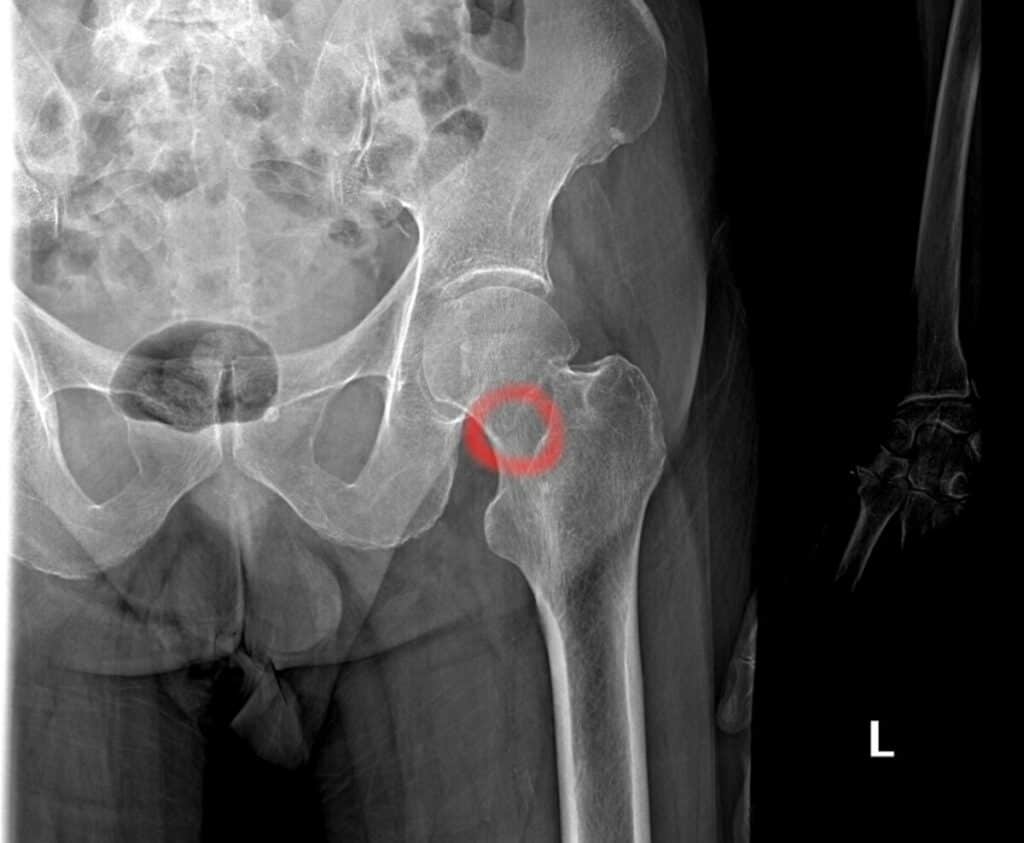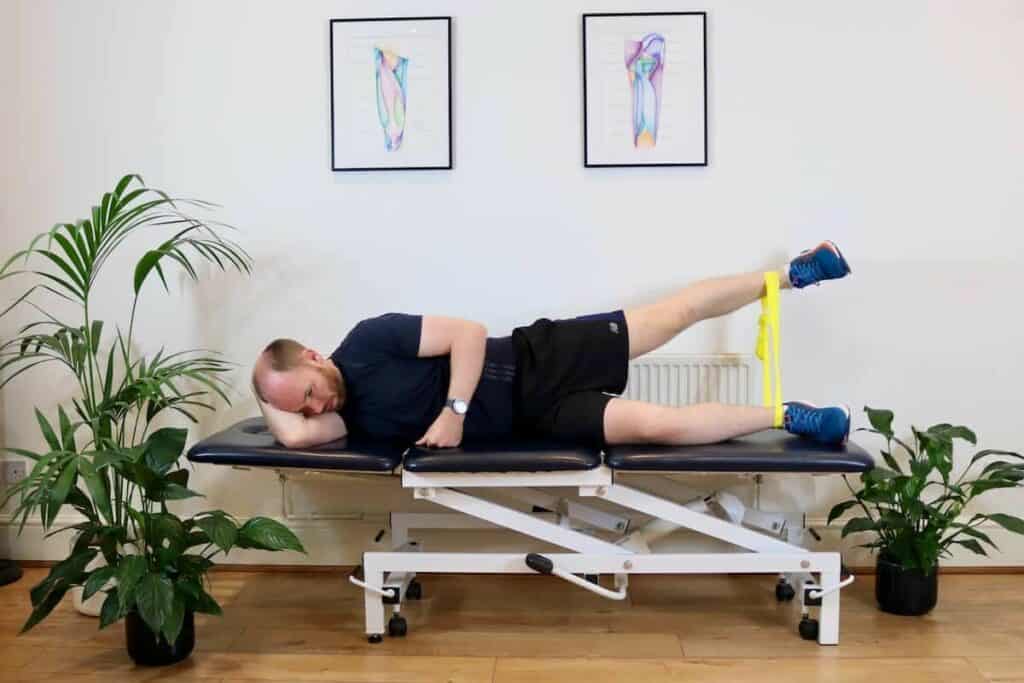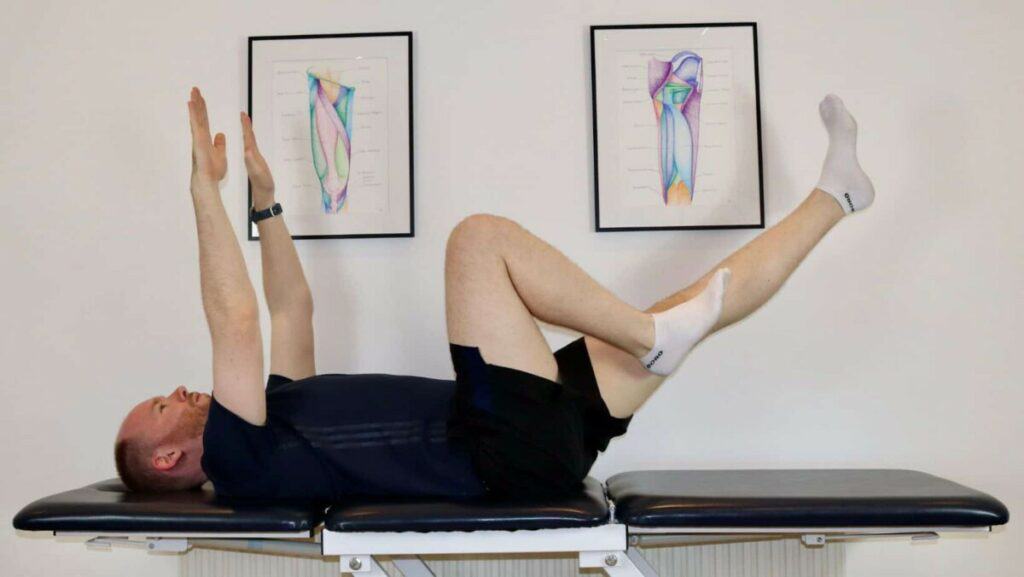Hip Stress Fracture
- Best Asics Shoes for Flat Feet - October 25, 2024
- Best Running Shoes for Flat Feet - October 22, 2024
- Posterior Tibial Tendonitis - October 21, 2024
Stress Fracture in Hip
A hip stress fracture is a painful condition that can occur following increased strain on the hip joint. A stress fracture in the hip is typically seen in professional athletes, military recruits, endurance runners, and other athletes with high volumes of high-impact training.
It is caused by the repetitive stress of the bone that causes this injury, unlike a fracture usually caused by a single high-force incident such as a fall. The most common area of a stress fracture is the neck of the femur, which is a narrow and angled portion of the bone which accounts for 3% of all stress fractures in athletes.
A stress fracture to this area is of concern as continued weight bearing on this injury can cause a full fracture due to the forces going through the weakened structure. In addition, the blood supply to the upper portion of the femur called the head, can be disrupted by a stress or full fracture, which can lead to the death of this tissue, called avascular necrosis.
Risk Factors Of Hip Stress Fractures
The significant risk factors of a stress fracture of the hip include a rapid increase in training volume without adequate rest, recovery and sleep, low body weight and eating disorder, osteoporosis or osteopenia, hypothyroidism or low vitamin D.
Other factors can increase the risk, such as excessive alcohol or caffeine consumption, smoking, lack of activity and certain medications such as oral steroids, long-term use of proton pump inhibitors, and some anti-epileptics (Wright et al, 2015) and (Krabak et al, 2021).
Weight-bearing and impact exercise can make the bones more robust, but only when done at an appropriate rate. If too much is done, the effect will be to weaken the bones, which can result in a bone stress response or stress fracture.

Hip Stress Fracture Symptoms
The most common symptom of a hip stress fracture is pain that worsens with activity. Usually, pain is located in the hip or groin or at the front of the thigh. Less often, a hip stress fracture will present with buttock pain. In more severe or advanced cases, pain can persist at rest and be noticed overnight.
There is rarely an area that you can specifically press to feel your pain. This is because the bone, deep within the joint, is affected and not a superficial structure. Pain will be reproduced with impact.
What does a hip stress fracture feel like?
Symptoms are usually described as feeling like a deep ache and only sharper pain as the fracture worsens. Sharper and more intense pain is usually only felt on aggravating activities, including weight bearing, walking, running, or jumping.
Initially, it is common for patients to describe that they feel aware of their hip or that it feels a bit uncomfortable. If training continues, this will usually worsen to the clearer symptoms of pain.
Hip Stress Fractures in Women
Women are more likely to develop stress fractures than men; within the athletic population, female runners are most at risk (Wentz et al, 2011). Women are particularly at risk of fractures, including stress fractures during menopause, as the reduction of oestrogen affects bone density.
Osteopenia and osteoporosis are more likely in post-menopausal women, a risk factor for a hip stress fracture. Menstrual irregularities, absence, and delayed menarche are helpful warning signs and a particular risk factor for stress fracture.
These are symptoms often overlooked or considered “normal” within certain sports where low body weight is desired, such as gymnastics and running. However, this symptom is not typical and should not be overlooked but investigated, as it can be used as a sign that the body is unhealthy.
Diagnosis
Clinical Examination
A clinical diagnosis of a hip stress fracture will be with a medical doctor or physical therapist. Clinically, patients often report a pattern of pain in extreme ranges of hip motion. There may be tenderness on palpation over the anterior aspect of the hip and the inguinal area.
Other clinical tests include the Fulcrum test and single-leg hip test. If these tests are positive, you should be referred for diagnostic imaging to confirm the diagnosis.
Imaging
Up to two-thirds of Hip Stress fractures do not show any signs of fracture on an X-ray; it is essential to have further imaging. The most accurate form of imaging for a stress fracture is an MRI scan, demonstrating 100% sensitivity, specificity and accuracy for diagnosing femoral neck stress fractures.
Hip Stress Fracture Treatment
Treatment for hip stress fracture varies depending on the cause of the stress fracture. Understanding the cause of a stress fracture is essential for a successful recovery.
Generally, treatment of a stress fracture of the hip will consist of a period of non-weight bearing, using crutches for all mobility. This allows for the bone to heal. Upper body and non-weight-bearing exercises can often continue during this period.
Factors influencing recovery time
Systemic Medical Conditions
Conditions such as Vitamin D deficiency, osteopenia and osteoporosis, amenorrhea, eating disorders/food restriction, and high emotional stress levels can all increase hip fracture risk. This may need additional treatment with medication, dietary changes, and psychological support.
Training
Training errors such as a rapid increase in running volume, ineffective or absent strength and conditioning, and insufficient recovery can contribute to hip stress fractures. They will benefit from education around safe training practices and varied running surfaces.
Biomechanics & Footwear
Poor biomechanics, such as excessive foot pronation, high arches and poorly chosen or worn footwear, can increase the risk of hip stress fractures.
Hip stress fracture recovery time
For most people, the period of non-weight-bearing will last between 4-8 weeks. Imaging will be repeated to check the status of the healing bone before returning to partial weight-bearing and gradually returning to full weight-bearing. Most people feel almost back to normal by 12 weeks, but it can take up to 4-6 months for the fracture to be fully healed and to return to unrestricted high-impact exercise such as running.
Hip stress fracture recovery time can be influenced by the individual’s general health, previous medical history, regular medications, bone health, pre-injury strength, and the contributing factors to the cause of the hip stress fracture mentioned previously. Adherence to physical restrictions, rest, and physical therapy during healing will also significantly affect healing time.
Hip Stress Fracture Exercises
Once the initial period of non-weight bearing has passed and scans have confirmed the bone is healing well, rehab can start. The initial phase of rehab will focus on the mobility of the hip joint and muscle flexibility. This will include stretches for the hip flexors, quadriceps, hamstring, glutes, calf, back, and abdominals.
Glute Bridge

Hip Abduction

Core Strengthening

The final phases of rehab are increasing impact and a gradual return to high-impact exercises, such as running.
Related Articles:
Hip Labral Tear – Outer Hip Pain – Total Hip Replacement
_______________________________________
We are specialists in Physiotherapy, with our clinic in Fulham, South West London.
We offer Online Appointments for £60 and Face-to-Face appointments for £85 in our clinics.

